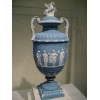|
 Once upon a
time there lived Josiah Wedgwood in England between 1730-1795. According
to Brockhaus and Efron Encyclopedic Dictionary, he was a potter, the founder of
the new English manufacture in clay. Thus, this definition was not sufficient to
talk about Wedgwood. Wedgwood opened his
working day in his father's shop and then he worked for Thomas Wildon
enterprise since 1754. He was especially admired in colored glaze. And in 1759 he founded his own manufacture
where he produced ceramics of all Stafford types,
and as such the company Wedgwood was initiated which has been the legend of
china work for over 2.5 centuries. The Queen of England showed her interest to
Wedgwood works which were lately added the status of «royal goods». Once upon a
time there lived Josiah Wedgwood in England between 1730-1795. According
to Brockhaus and Efron Encyclopedic Dictionary, he was a potter, the founder of
the new English manufacture in clay. Thus, this definition was not sufficient to
talk about Wedgwood. Wedgwood opened his
working day in his father's shop and then he worked for Thomas Wildon
enterprise since 1754. He was especially admired in colored glaze. And in 1759 he founded his own manufacture
where he produced ceramics of all Stafford types,
and as such the company Wedgwood was initiated which has been the legend of
china work for over 2.5 centuries. The Queen of England showed her interest to
Wedgwood works which were lately added the status of «royal goods».
The absurdity
by Wedgwood is that he did not create anything new, he is not the founder of any
particular style, and he borrowed many ideas from competitors. Wedgwood is the
real Victorian eclectics, this is the soft and flexible toys, sensitive,
picturesque and of high quality.
Wedgwood vases
are replicated from the Sevres Manufacture, though they are more popular than
items made in Sevres. Wedgwood was in the top of first designers who initiated
Egyptian patterns and motive onto his items, and nevertheless, his items were
of higher demand. Later than the Italians he started to restore the red-figure
patterns on vases of Italian and Roman origin (so called « Etruscan») - and the
items were of higher demand than the «original copies». The ornaments and patterns
were borrowed by Wedgwood from two of his brothers, another paradox phenomenon
by Wedgwood brothers, who are believed to be the greatest architects and
designers, who were not as popular as Wedgwood.
As Novalis said,
Goethe was the same as Wedgwood for English culture, and
here the minstrel wanted to sting Goethe while flattering Wedgwood. And this is
interesting but Goethe is as vulnerable as every tea set, a mug, and vases.
Very
typical «style of drawing» by Wedgwood, one of his most famous masterpieces is reproduction
of Portland
vase. Roman vase, made at the end of I century B.C., that was in the collection
of Lord Hamilton, bought by the Duchess of Portland, in awe of all
neoclassicists. But Wedgwood thought of the ingenious and simple solution: and exactly
the same vase, but better. As a result, the reproduced masterpiece with amazing
accuracy was created, and thus was able to improve in both technique and color.
Moreover, it is possible to replicate vases, but it is affordable to Wedgwood
only, and vases and remained works of art were valuable even when replicated.
Wedgwood
produced his famous sets not only for the British crown. For the sake of
Catherine II, a lover of luxury porcelain, Wedgwood ordered a big set to the
species of England.
The table ware was intended for suburban Palace (in Finnish - «Frog Bog»).
Because of such names green frog was chosen as the emblem on each set. Dinner
set is called «Green Frog». This was a sample of quiet rococo, faithful to the
neo-classicism. It is said that Catherine II did not show much interest in the smooth
eclecticism, and the set «Green Frog» was not to her taste. Maybe so, but the
empress were well aware that such a personal image and the image of the state -
to acquire the set of Wedgwood by the Russian Imperial House. Now the set «Green
Frog» is stored in the Hermitage and is one of the most outstanding treasures
of this museum.
After the
death of Wedgwood, his work were continued by his sons, keeping the tradition,
the father founded, highest quality and meticulous monitoring of fashion
trends. Thus, in the XIX century Wedgwood manufactory produced dishes styled as
Chinese porcelain were the most fashionable porcelain of that time.
In 1987,
the Wedgwood Company teamed up with Waterford Crystal (Irish manufacturer of
crystal), forming a joint company, Waterford-Wedgwood. This company continues
to produce elite porcelain, which is the example of grace, elegance and
quality.
|